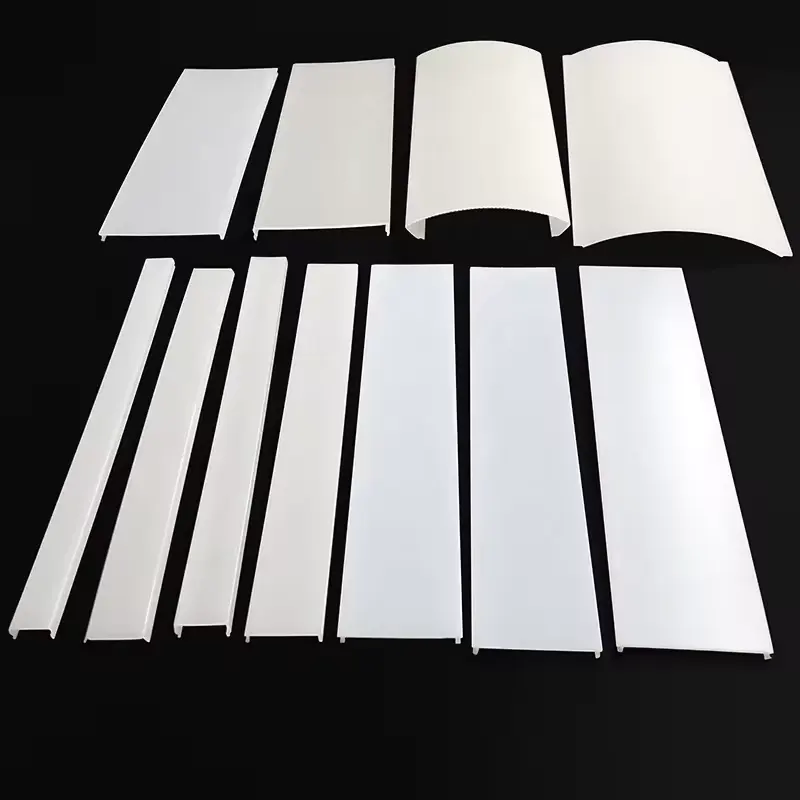When choosing materials for lampshades, it’s important to understand the differences between PVC and PMMA lampshade strips. Both materials have unique properties, and selecting the right one can make a significant impact on the durability and appearance of your lampshade. Let’s explore the distinctions between PVC lampshade strips and PMMA lampshade strips.
What Are PVC Lampshade Strips?

PVC (Polyvinyl Chloride) is a widely used thermoplastic polymer, made by polymerizing vinyl chloride. It is known for its durability and chemical resistance. Below are some key characteristics of PVC lampshade strips:
- High Hardness: PVC offers good rigidity, which is suitable for applications that require a strong and durable material.
- Chemical Resistance: PVC is resistant to organic and inorganic acids, alkalis, and salts, making it less prone to corrosion.
- Translucence: Though not fully transparent, PVC lampshades allow some light to pass through, giving a muted glow.
- Application: PVC is often used in industrial settings for pipes and protective films, but its adaptability makes it suitable for lampshades as well.
What Are PMMA Lampshade Strips?

PMMA (Polymethyl Methacrylate), commonly known as acrylic, is another popular material for lampshade strips. PMMA offers excellent optical clarity and has properties that make it a suitable alternative to glass in many applications.
Key characteristics of PMMA lampshade strips include:
- Outstanding Transparency: PMMA has higher optical transparency than PVC, making it ideal for lampshades where light diffusion is a priority.
- Weather Resistance: PMMA is highly resistant to environmental factors like UV rays, making it a great option for both indoor and outdoor lighting.
- Mechanical Strength: PMMA lampshade strips offer good rigidity and flexibility, giving them a durable yet elegant feel.
- Application: PMMA is commonly used in street lighting, car lenses, and outdoor signage due to its transparency and weather resistance.
Key Differences Between PVC and PMMA Lampshade Strips
1. Transparency
When it comes to transparency, PMMA lampshade strips are more transparent than PVC lampshade strips. PMMA allows more light to pass through, which enhances brightness, while PVC gives a more diffused, softer light.
2. Chemical Resistance
While both materials are chemically resistant, PVC is more resistant to acids, alkalis, and salts, making it less susceptible to corrosion in industrial environments. In contrast, PMMA is more vulnerable to strong corrosive solvents, but offers better resistance to weather conditions.
3. Weather Resistance
PMMA lampshade strips are more resistant to UV radiation and weathering, making them ideal for outdoor applications. PVC, although durable, is less resistant to environmental factors and may degrade over time when exposed to harsh conditions.
4. Surface Hardness
The surface hardness of PMMA lampshades is generally higher than that of PVC lampshades. You can test this by lightly scratching the surface with your fingernail. PVC will show marks more easily because it has a softer surface, while PMMA is more resistant to scratches, especially if coated with protective layers.
5. Heat Resistance
In terms of heat resistance, PMMA performs better in moderate temperature conditions, while PVC may deform at higher temperatures. This makes PMMA lampshade strips more suitable for environments where heat exposure is a concern.
How to Choose Between PVC and PMMA Lampshade Strips?
- For Higher Transparency and Aesthetic Appeal: If you’re looking for clearer light diffusion, PMMA lampshade strips are the better choice.
- For Chemical Resistance and Durability: In more industrial or harsh environments, PVC lampshade strips are ideal due to their strong resistance to acids, alkalis, and other chemicals.
- For Outdoor Applications: Choose PMMA if the lampshade will be exposed to outdoor conditions, as it holds up better against weather and UV radiation.
Conclusion
In summary, both PVC lampshade strips and PMMA lampshade strips have their unique advantages. PVC is great for its chemical resistance and cost-effectiveness, while PMMA excels in transparency and weather resistance. When choosing the right material for your lampshade, consider the specific environment and lighting needs to ensure optimal performance and longevity.
